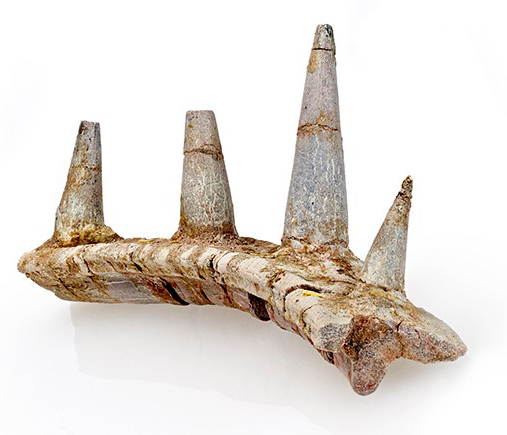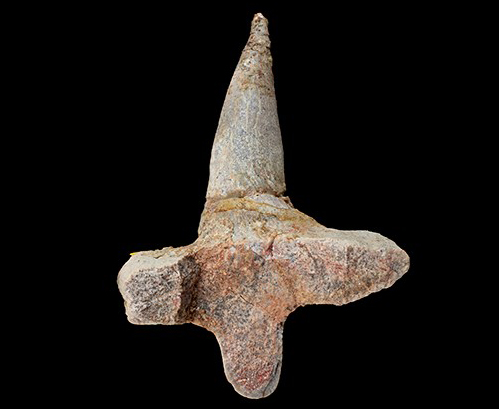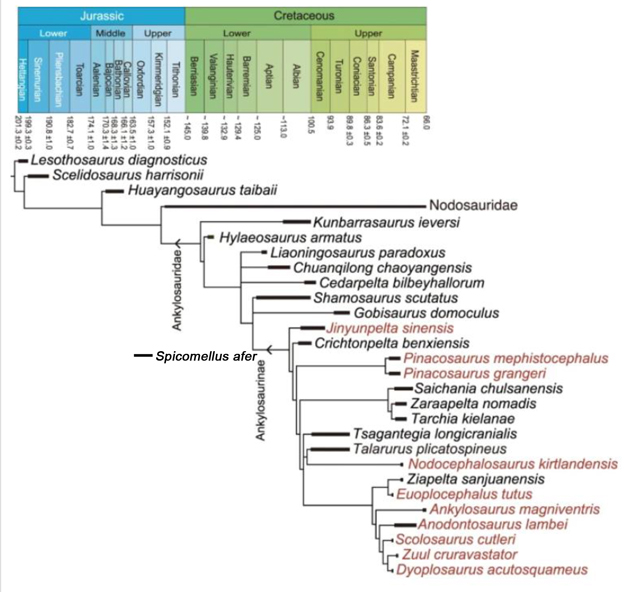The Earliest Ankylosaur and Africa’s First
Scientists including researchers from the Natural History Museum in London, have published a scientific paper announcing the discovery of the first fossils assigned to the Ankylosauria from Africa. This is the first ankylosaur to have been named from fossil material found in Africa and also the oldest known member of this group of armoured dinosaurs described to date. The dinosaur has been named Spicomellus afer. The scientific name translates from the Latin as “spiked collar from Africa”.

Acquired from a Fossil Dealer
The fossil was acquired from a UK-based commercial fossil dealer by the London Natural History Museum in 2019. At first the strange fossil, a rib bone with four bony spikes directly attached to it, was thought to be a forgery, but CT analysis proved the fossil to be genuine. It comes from the third subunit of the El Mers Group from the Atlas Mountains of Morocco. The fossil is estimated to be between 168 and 163 million years old (Bathonian to Callovian stages of the Middle Jurassic).
In recent times, Morocco has provided some tantalising glimpses into the potential wealth of armoured dinosaurs that await discovery. The Ankylosauria and Stegosauria form a clade within the bird-hipped dinosaurs (Ornithischia), the Eurypoda, which has been defined to include famous armoured dinosaurs Ankylosaurus, Stegosaurus and their most recent, common ancestor and all its descendants. Eurypoda fossils are mostly confined to Laurasia, fossils from the continents that made up Gondwana (essentially Africa, South America, Antarctica, India, Madagascar and Australia), are rare.
In 2019, Everything Dinosaur reported upon the discovery of the oldest stegosaur known from northern Africa, the dinosaur named Adratiklit boulahfa is also the oldest stegosaur described to date and it was roughly contemporaneous with Spicomellus.
To read our blog post on Adratiklit boulahfa: North Africa’s First Stegosaur.
The research team behind the paper on Adratiklit boulahfa were also responsible for much of the work behind the analysis of the rib bone fossil (specimen number NHMUK PV R37412), that led to the naming and scientific description of Spicomellus.
Identifying a Fossil as an Ankylosaur Fossil
Once the fossil had been established as genuine, the research team including Dr Susannah Maidment (London Natural History Museum), who specialises in studying ornithischian dinosaurs, were able to confirm that the specimen represented a rib bone from a stegosaur or an ankylosaur. Rib bones in most armoured dinosaurs tend to show a distinctive “t-shape” in cross section. Histological analysis of the composition of the bone matrix of the spikes demonstrated that their structure was reminiscent of an ankylosaur and therefore the scientists were able to confidently assign this specimen to the Ankylosauria.

As for what Spicomellus might have looked like, any life reconstructions will have to be highly speculative, although based on comparisons with the ribs of more complete ankylosaur specimens the research team estimate that this individual Spicomellus was around three metres in length.
No Fossil Like This Ever Found Before
The rib with spiked, dermal armour fused to its top surface is unique. Nothing like this has ever been found before. This anatomical trait is not found in living or extinct vertebrates. Ankylosaurs tend to have their armour embedded into their skin and not directly attached to their bones. Spicomellus would have been less mobile and flexible as a result of its unique anatomy. Palaeontologists hope to return to northern Morocco and find more fossils to help them build up a better picture of this bizarre, armoured dinosaur.
Described as a basal ankylosaur, Spicomellus may represent an evolutionary experiment as armoured dinosaurs evolved probably as a result of predation pressure (megalosaurids are also known from the El Mers Group). How long these armour-attached-to-bone ankylosaurs persisted and how successful this group was remains unknown.
Implications for Armoured Dinosaur Evolution and Stegosaur Extinction
The discovery of Spicomellus suggests that we have a lot more to learn about the Eurypoda and that there probably are many more important but unknown fossil specimens of armoured dinosaurs awaiting discovery in the continents that made up Gondwana.
Spicomellus helps to fill a gap in the evolution of the Ankylosauria (Nodosauridae and Ankylosauridae). In addition, its discovery challenges current thinking about the demise of the Stegosauria. Stegosaur fossils are more common in Jurassic rocks than ankylosaur fossils are.
The Earliest Ankylosaur
In Cretaceous sediments, stegosaur specimens become increasingly rare. It had been thought that the rise of the Ankylosauria played a role in the eventual demise and extinction of the Stegosauria. However, with the discovery of Spicomellus, palaeontologists now know that stegosaurs and ankylosaurs co-existed for around 20 million years. The extinction of the Stegosauria remains a mystery, Spicomellus suggests that the evolution of different types of armoured dinosaur may only have played a limited role in their extinction.

The scientific paper: “Bizarre dermal armour suggests the first African ankylosaur” by Susannah C. R. Maidment, Sarah J. Strachan, Driss Ouarhache, Torsten M. Scheyer, Emily E. Brown, Vincent Fernandez, Zerina Johanson, Thomas J. Raven and Paul M. Barrett published in Nature Ecology and Evolution.
The Everything Dinosaur website: Dinosaur Toys.

